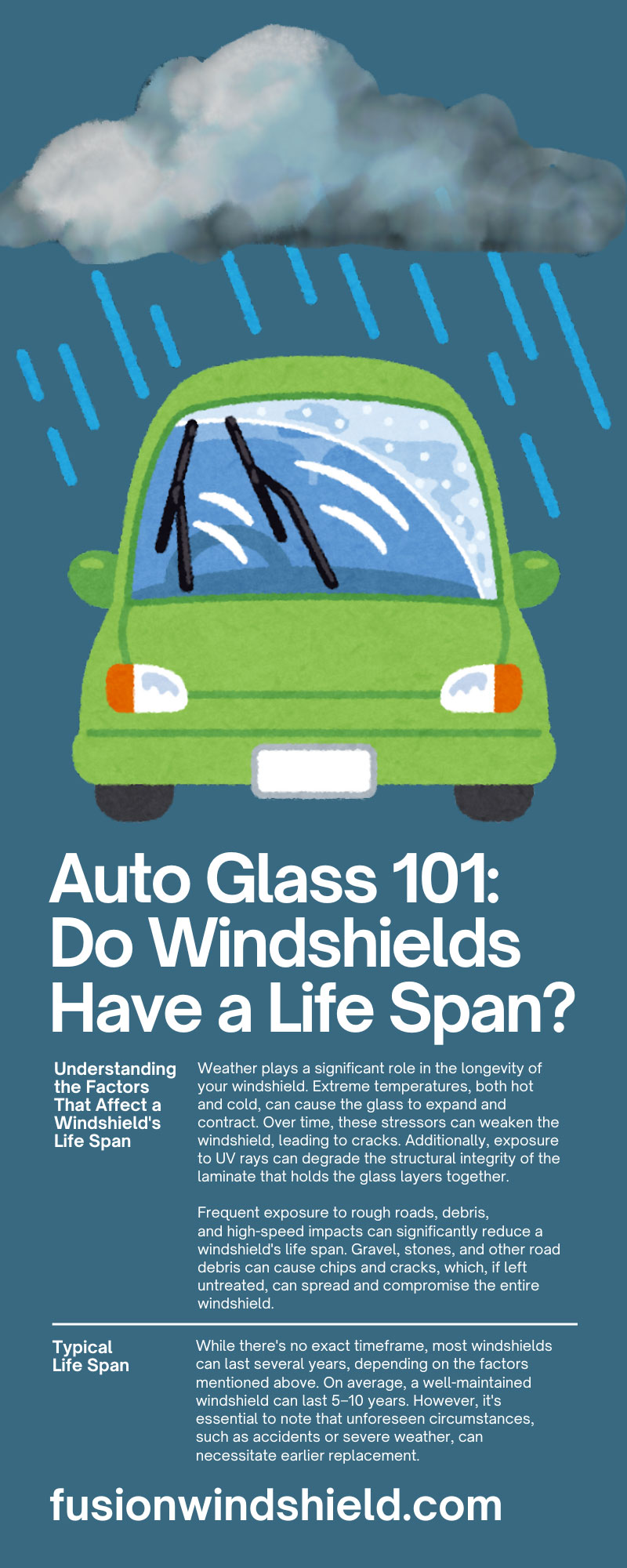When considering the most important components of a vehicle, windshields might not immediately come to mind. However, their role in ensuring both driver and passenger safety is paramount. More than just a barrier against the elements, windshields provide structural integrity to the vehicle, prevent occupants from being ejected during collisions, and ensure clear visibility. Given their importance, it’s crucial to ask, do windshields have a life span?
By exploring this idea, it’s easier for auto mechanics and how car owners to maintain them effectively and ensure their driving experience is safe and comfortable.
Understanding the Factors That Affect a Windshield’s Life Span
Manufacturers design windshields to last, but they can break down over time, especially when exposed to the elements or when you put off important repairs.
Weather Conditions
Weather plays a significant role in the longevity of your windshield. Extreme temperatures, both hot and cold, can cause the glass to expand and contract. Over time, these stressors can weaken the windshield, leading to cracks. Additionally, exposure to UV rays can degrade the structural integrity of the laminate that holds the glass layers together.
Driving Conditions
Frequent exposure to rough roads, debris, and high-speed impacts can significantly reduce a windshield’s life span. Gravel, stones, and other road debris can cause chips and cracks, which, if left untreated, can spread and compromise the entire windshield.
Maintenance
Regular maintenance and prompt repairs can extend the life of your windshield. Minor chips and cracks can often be repaired if addressed early, preventing the need for a full replacement. Proper cleaning with non-abrasive cleaners also helps maintain visibility and prevent damage.
Signs of a Deteriorating Windshield
While, in some cases, damage to a windshield can happen all at once, there are often signs that the structure is weakening over time.
Chips and Cracks
One of the most obvious signs of a deteriorating windshield is the presence of chips and cracks. These can occur from road debris, weather conditions, or even minor accidents. While small chips might seem insignificant, they can quickly spread, especially under stress from temperature changes or further impacts.
Discoloration
Over time, windshields can develop a hazy or discolored appearance, particularly around the edges. This can result from prolonged exposure to UV rays, pollution, or improper cleaning agents. Discoloration can impair visibility and indicate that the windshield is weakening.
Wiper Blade Damage
Old or damaged wiper blades can scratch the surface of your windshield in addition to leaving streaks that interfere with visibility and clarity. Regularly inspect and replace your wiper blades to prevent this type of damage. Ensure you purchase quality replacements to avoid further problems.
The Average Life Span of a Windshield and How to Extend It
Getting the most out of your windshield is essential for saving money and ensuring your vehicle is in good condition.
Typical Life Span
While there’s no exact timeframe, most windshields can last several years, depending on the factors mentioned above. On average, a well-maintained windshield can last 5–10 years. However, it’s essential to note that unforeseen circumstances, such as accidents or severe weather, can necessitate earlier replacement.
Maintenance Tips
Regular maintenance and repairs will help you extend the life span of your windshield. Remember to perform these tasks regularly:
- Prompt repairs: Address chips and cracks as soon as they appear. Small repairs are often quick and affordable, preventing more extensive damage.
- Proper cleaning: Use a soft cloth and non-abrasive glass cleaner. Avoid harsh chemicals and abrasive pads that can scratch the glass.
- Protect from extreme temperatures: Whenever possible, park your car in a garage or shaded area. Use a sunshade to protect the interior and windshield from excessive heat.
- Replace wiper blades: Inspect your wiper blades every six months and replace them if they show signs of wear.
By creating and sticking to a routine, you can ensure your windshield lasts as long as possible.
The Process of Windshield Repair and Replacement
Understanding the process of windshield repair and replacement is key to a worry-free driving experience.
Repair
Windshield repair involves injecting resin into the chip or crack, which is then cured and polished. This process restores the structural integrity of the glass and improves visibility. Repairs are typically quick, taking about 30 minutes to an hour, and are significantly less expensive than replacements.
Replacement
When damage is too extensive for repair, windshield replacement is necessary. The process involves removing the damaged windshield and installing a new one using a strong adhesive. Replacements can take a few hours, and it’s crucial to choose a reputable service provider to ensure proper installation.
Finding a Reliable Service Provider
If you’re having trouble with replacement, the best auto glass services are right at your fingertips. Here are some tips to keep in mind when looking for a provider:
- Check reviews: Look for customer reviews and ratings online to gauge the reputation of the service provider.
- Certifications: Ensure the technicians are certified by organizations like the National Glass Association (NGA).
- Warranties: Opt for providers that offer warranties on their work, ensuring you’re covered if issues arise post-installation.
Keeping Your Windshield in Good Condition: Best Practices
At the end of the day, prevention is the best way to keep your windshield in good condition. Here are some things you should be in the habit of:
- Avoid slamming doors: Slamming doors can cause vibrations that may worsen existing chips or cracks.
- Regular inspections: Periodically inspect your windshield for any signs of damage or wear.
- Use Gentle Wipers: Ensure your wiper blades are in good condition and free from debris.
- Drive carefully: Maintain a safe distance from other vehicles, especially on gravel roads, to minimize the risk of debris impact.
Proper Storage Techniques
Proper storage can also play a crucial role in maintaining the integrity of your windshield. If you need to store your vehicle for an extended period, follow these tips to protect the windshield:
- Indoor storage: Whenever possible, store your vehicle in a garage or indoor facility. This shields the windshield from harsh weather conditions, UV rays, and falling debris.
- Car covers: If indoor storage isn’t available, use a high-quality car cover. This can provide an additional layer of protection against the elements.
- Climate control: Try to store your vehicle in a location with stable temperatures to prevent the glass from expanding and contracting.
- Clean before storing: Ensure the windshield is clean and free of any debris before storing the vehicle. Dirt and grime can harden over time, making them harder to remove later.
- Periodic checks: Even in storage, periodically check your vehicle. This allows you to spot and address any issues, such as leaks that could damage the windshield, before they become significant problems.
Don’t Wait To Fix a Degraded Windshield
Your windshield plays a vital role in your vehicle’s safety and functionality. While various factors can degrade it, proper maintenance and timely repairs can extend its life significantly. By prioritizing your windshield’s health, you ensure not only your safety but also the longevity of your vehicle.
Windshields do have a life span. If you notice signs of wear on your windshield, don’t wait until it’s too late. Reach out to a professional service provider today and keep your drive safe and clear!



Recent Comments